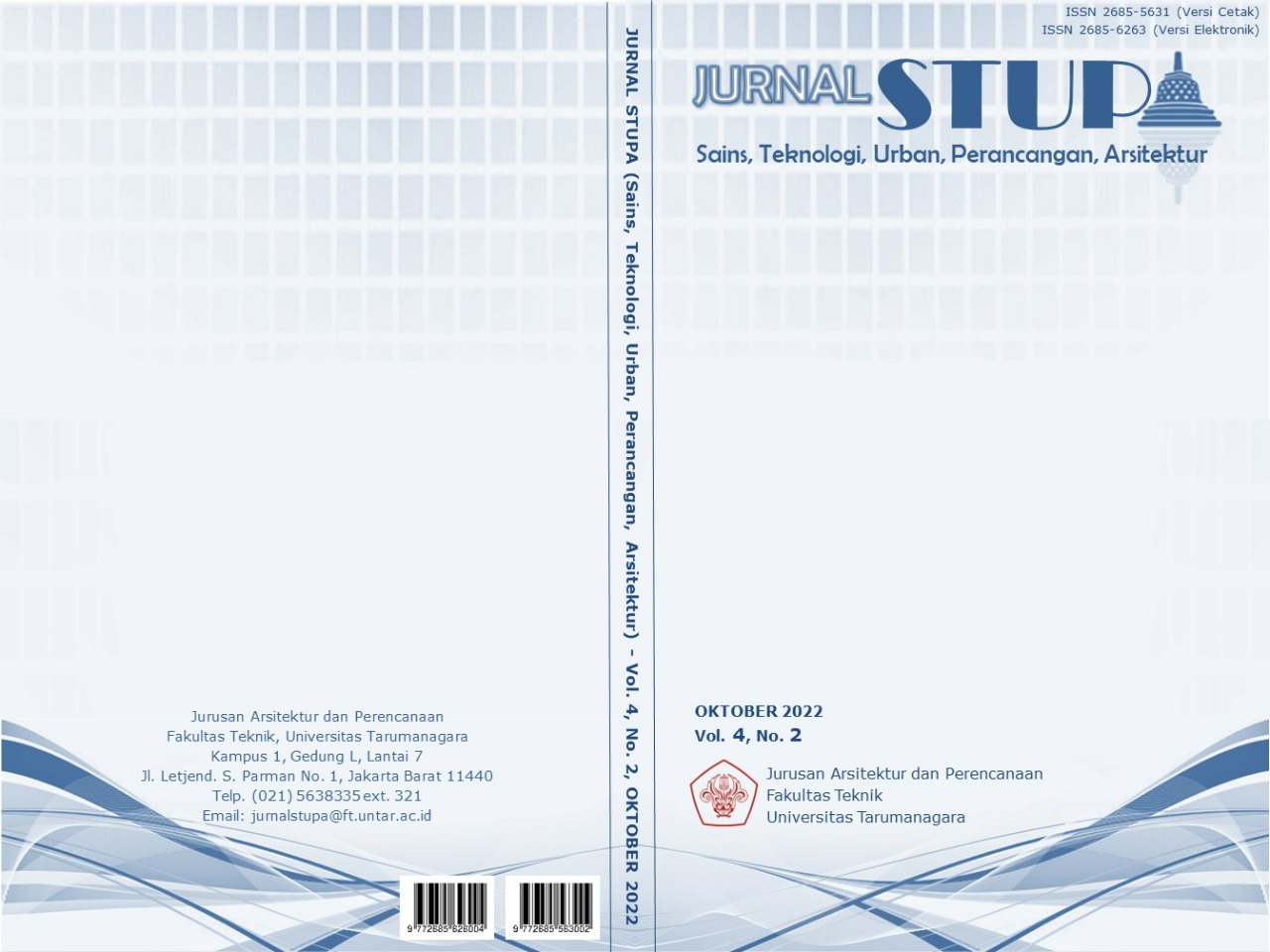PENERAPAN KAMUFLASE ARSITEKTUR TERHADAP PENGEMBANGAN LANSKAP CITADELWEG SEBAGAI TITIK AKUPUNKTUR KOTA
Isi Artikel Utama
Abstrak
Any form of wandering will end up in a list or dictionary of events and objects. The discovery of patterns created from several events and architectural objects becomes a common thread or essence that binds the whole journey. Similar to tourism trips, making continuity between viewing points or attractions in the Medan Merdeka area, fosters historical value as a city-forming layer that opens up future development collectively. The physical transformation of several attractions or spectacles at Medan Merdeka and the design site shows three main architectural components; the heritage of Dutch East Indies buildings, the Indonesian Modern Architecture and the city landscape as the center of Medan Merdeka. Around the passive space under Jalan Veteran I or Citadelweg railway which is the design site, each city spectacle stands separately and disconnect the tourism and daily movements. The three components of the design scheme have different principles as a city spectacle. Seeing the three broadly becomes a camouflage tool to explore the layers of city structure, and how it relates to the modern city today. To understand how to connect these three components as an architectural intervention that can be a camoflour at the urban acupuncture points of Medan Merdeka and produce a sense of place in the design. The design creates continuity between Juanda's attractor and Medan Merdeka through the application of four camouflage methods in the design: (1). Camouflage the city as a spectacle through the merging of monumental towers and arch rhythms from the Dutch East Indies in architectural form; (2). City camouflage as a spectacle through the Indonesian Heritage Gallery and the Jakarta City Project program; (3). Reclaiming negative space under the Citadelweg railroad with landscape camouflage; (4). Using the 'speed' of trains for Citadelweg's business productivity through innovation and collaboration with NGOs.
Keywords: Architecture and NGOs, Architectural Camouflage, Citadelweg Landscape, Medan Merdeka Tourism, Under Railroad Space Utilization
Abstrak
Segala bentuk wandering akan berujung pada daftar atau kamus dari beberapa peristiwa dan objek. Penemuan pola dari beberapa peristiwa dan objek arsitektur menjadi benang merah atau esensi yang mengikat keseluruhan perjalanan. Sama halnya dengan perjalanan turisme, kesinambungan antar titik tontonan atau atraktor kawasan Medan Merdeka menumbuhkan nilai historis sebagai lapisan pembentuk kota yang membuka pengembangan di masa depan secara kolektif. Transformasi fisik beberapa atraktor atau tontonan di Medan Merdeka dan tapak rancangan menunjukan tiga komponen arsitektur utama yang dimiliki yaitu; peninggalan bangunan Hindia Belanda yang dipertahankan, Arsitektur Modern Indonesia dan lanskap kota sebagai sentral Medan Merdeka. Di sekitar ruang pasif bawah rel kereta Jalan Veteran I atau Citadelweg yang menjadi tapak rancangan, tiap tontonan kota berdiri secara terpisah dan terputus secara pergerakan turisme maupun keseharian. Ketiga komponen skema desain memiliki prinsip yang berbeda-beda sebagai sebuah tontonan kota. Melihat ketiganya secara luas menjadi alat kamuflase untuk mengeksplorasi lapisan-lapisan pembentuk kota, serta bagaimana relasinya dengan kota modern sekarang. Untuk mengerti bagaimana menghubungkan ketiga komponen tersebut sebagai intervensi arsitektur yang dapat menjadi camoflour di titik Akupunktur perkotaan Medan Merdeka dan menghasilkan jiwa tempat dalam rancangan. Rancangan desain menciptakan kontinuitas atraktor Juanda dengan Medan Merdeka melalui empat penerapan metode kamuflase dalam rancangan desain yaitu: (1). Kamuflase kota sebagai tontonan melalui penggabungan tower monumental dan ritme arch peninggalan Hindia Belanda dalam bentuk arsitektur; (2). Kamuflase kota sebagai tontonan dalam program Galeri Pusaka Indonesia dan Jakarta City Project; (3). Merebut kembali ruang negatif bawah rel kereta Citadelweg dengan kamuflase lanskap; (4). Menggunakan ‘kecepatan’ kereta untuk kegaiatan produktif melalui inovasi dan kolaborasi dengan NGO.
Rincian Artikel

Artikel ini berlisensiCreative Commons Attribution-NonCommercial-ShareAlike 4.0 International License.
This work is licensed under a Jurnal Sains, Teknologi, Urban, Perancangan, Arsitektur/ STUPA Creative Commons Attribution-NonCommercial-ShareAlike 4.0 International LicenseReferensi
Campbell, Alexandra. (2020). Venice’s Veneer Masks, Façades and Theatre. London: Bartlett School of Architecture.
Gehl, Jan. (2019). Soft City Building Density for Everyday Life. Washington DC: Island Press.
Leach, N. (2006). Camouflage. The MIT Press.
Lerner, Jaime. (2014). Urban Acupuncture. Washington: Island Press.
Moss, E. Owen. (2016). The New City: I'll See It When I Believe It. Retrieved March 14, 2022, from https://www.youtube.com/watch?v=fr2-b_PiAAM
Rossi, Aldo. (1982). The Architecture of the City. The MIT Press.
Sutanto, A. (2020). Peta Metode Desain. Jakarta: Universitas Tarumanagara.



